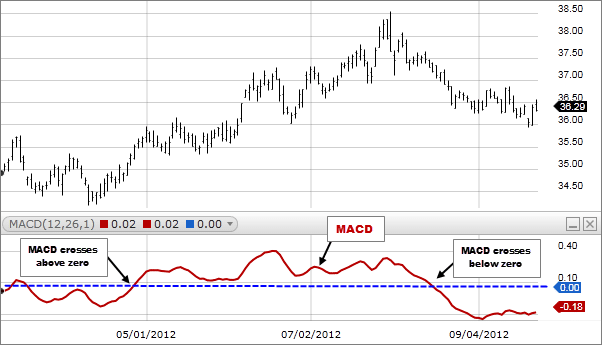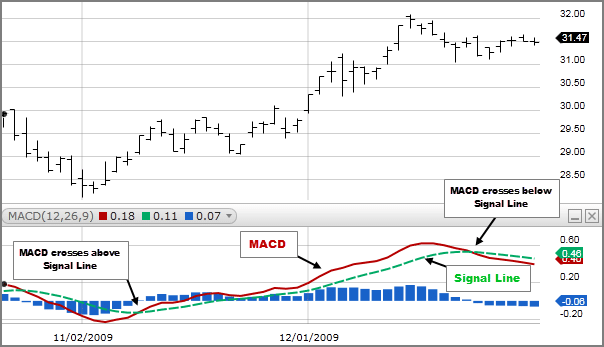‘Identify a trend, stay with it, and you are sure to make a fortune’ is an old saying that has stood the test of time in the forex market. Most trading strategies are based on identifying the underlying trend to try and ride the wave. While there are many indicators used to identify market trends, one stands out.
Understanding Moving Average conversion and diversion indicator
Let’s look at the indicator that makes it easy to ascertain whether the price is likely to increase or decrease. While it can hint that a market is trending up or down, it does not provide any information on whether an asset has been oversold or overbought, which is essential to knowing when to stay out.
Outline
It appears as a chart at the bottom with two lines and a histogram in trading platforms.

The outlines move up and down, crossing over to gesture prevailing momentum.
How does it work?
Whenever the MACD line rises from below zero and starts edging higher, a currency pair is considered bullish and likely to continue edging higher. Similarly, whenever it moves from the positive territory, and its reading is negative, the market is deemed to be bearish, gesturing that a currency pair will likely continue dropping.
The signal is the slow-Moving Average and does not respond rapidly to price changes, thus commonly used to smoothen the sensitivity of the analysis tool. In contrast, the MACD is the fast-Moving Average that reacts quickly to price changes, thus edging above and below the signal line.
The histogram is used to show the strength of the upward or downward momentum. Additionally, it plots the difference between the two Moving Averages, thereby making it easy to know whether the underlying trend is strengthening or weakening.
Whenever the indicator is above zero, hunting bullish momentum, the histogram is also positive. It grows in size as the upward momentum increases. Whenever the upward momentum is contracting, its size also tends to shrink, becoming smaller.
The histogram appears below zero whenever there is bearish bias with short sellers in control. It grows in size as the downward momentum increases and shrinks as the momentum decreases. As is the case during periods of bullish momentum, it grows larger as the speed of the downward momentum increases.
Consequently, it is relied upon to identify the strength of price movement in a given direction. The larger the size in either direction, the higher the likelihood of orders getting filled.

In addition, a strong buy pointer comes into play whenever the indicator crosses the signal line from below and starts traveling up.

The further up it moves, and the gap between the two averages increases, the stronger the uptrend and the likelihood of price edging higher.
What to remember?
During periods of heightened volatility, the MACD will move up and down the zero level making it extremely difficult to pinpoint the exact direction the market is trending. In addition, it crosses the signal outline back and forth, all but complicating the analysis.
It is important to be extremely cautious during such periods, especially for trend-following traders—the wild swings hint of no clear trend. One should only look to enter once the dust settles and the indicator starts traveling in one direction without quick reversals.
The histogram can also provide valuable information on when to trigger a position and when to exit. For instance, if it is in positive territory and enlarging, one can enter a buy position as soon as the MACD crosses the signal outline and trends up. One can stay in the long position as long as its size does not exceed the previous swing high. As soon as it rises to the last swing high, one can look to exit as a correction could come into play.
Divergence
The MACD is also effective in identifying divergence. Such scenarios occur whenever price and the indicator are edging in the opposite direction. It is often expected that the two will always align and travel in the same direction.
For instance, whenever it crosses the signal outline and moves above the zero level, it is expected that the price will also trend up. Similarly, whenever it crosses the signal and moves below, breaching the zero level and into negative territory, it is expected that the price will also continue dropping.
However, that is not always the case. Whenever MACD and price are traveling in the opposite direction, the same acts as an early warning sign that a reversal in the prevailing trend is likely to occur. For instance, if the asset price was edging lower, there is usually a high likelihood of it changing course and starting to ascend.

The chart above shows that the price was descending in the first phase, making lower lows. However, the MACD crossed the signal and continued making higher lows instead of lower lows. The indicator forming higher lows beckoned waning downward momentum as short-sellers were increasingly losing their edge.
After some time, it is clear that the price reversed from the downtrend and started trending up with the indicator.
Limitations
Just like any other analysis tool, MACD cannot be relied upon to constantly provide accurate information on entry and exit points in the currency market. It should always be used in combination with others for better outcomes. For instance, it can hint at a potential reversal whenever a divergence occurs. Nevertheless, instead of the reversal occurs, the price can continue edging in the prevailing direction without reversing as hinted.
In addition, a crossover between the MACD and signal line can occur to motion that the price is about to move up in a given direction only to reverse immediately and move in the opposite direction.




